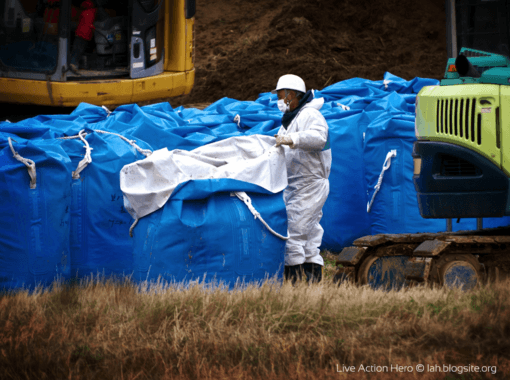
Photo by Live Action Hero | CC BY 2.0
Fukushima is full of nasty surprises, similar to John Carpenter’s classic film The Thing (1982), which held audiences to the edge of their seats in anticipation of creepy monsters leaping out from “somebody, anybody, nobody knows for sure,” but unlike Hollywood films, Fukushima’s consequences are real and dire and deathly. It’s an on-going horror show that just won’t quit.
Only recently, a team of international researchers, including a group of scientists from the University of Manchester/UK and Kyushu University/Japan made a startling discovery. Within the nuclear exclusion zone in paddy soils and at an aquaculture center located several miles from the nuclear plant, the research team found cesium-rich micro-particles.
Evidently, the radioactive debris was blown into the environment during the initial meltdowns and accompanying hydrogen blasts. Accordingly, the environmental impact of radiation fallout may last much longer than previously expected. (Source: New Evidence of Nuclear Fuel Releases Found at Fukushima, University of Manchester, Phys.org, Feb. 28, 2018)
According to Dr. Gareth Law, senior lecturer in Analytical Radiochemistry at the University of Manchester: “Our research strongly suggests there is a need for further detailed investigation on Fukushima fuel debris, inside, and potentially outside the nuclear exclusion zone. Whilst it is extremely difficult to get samples from such an inhospitable environment, further work will enhance our understanding….” Ibid.
Their discovery dispels the long-held view that the initial explosion only emitted gaseous radionuclides. Now, it is clear that solid particles with very long-lived radionuclides were emitted. The research team did not discuss the likely impact, as more analysis is necessary before drawing conclusions.
Decidedly, they’d best hurry up, as the Olympics are scheduled for 2020.
Still, this discovery smacks in the face the government’s and TEPCO’s statements about successful cleanup efforts and pressuring prior residents to return to homes in the exclusion zones.
In another recent development, lethal levels of radiation have unexpectedly popped up in leaks at the nuclear plant facility, as explained in an article by Jeff Farrell: Fukushima Nuclear Disaster: Lethal Levels of Radiation Detected in Leak Seven Years After Plant Meltdown in Japan, Independent/UK, Feb. 2, 2018.
TEPCO has discovered lethal levels of radiation leaking around the facilities, radiation that would kill a person within one-hour of exposure. Even though this is not entirely a surprise with 100% total meltdowns and tons of radioactive corium sizzling wildly underneath, irradiating like crazy. This is why radioactive water continues flowing into the Pacific Ocean, necessitated to cool white-hot sizzling corium. Nobody knows what the long-term effect will be for the ocean, but guaranteed, it cannot be good.
Furthermore and distressingly, Mycle Schneider of the World Nuclear Industry Status Report claims, “TEPCO does not have a clue” to decommissioning the plant. That’s not comforting, knowing that mistakes could circumnavigate the planet much worse than the current flow of radioactive water into the Pacific, thus turning into a global catastrophe of unspeakable proportions.
After all, according to the Japan Meteorological Agency, the country has 100,000 earthquakes every year. Who knows what can happen to rickety broken down nuclear reactors in a country that slip slides so easily, so readily, so often, totally unpredictably.
According to Schneider: “It’s a disaster of unseen proportions.” The radiation leaks, coupled with inappropriate storage of radioactive waste has global consequences. Schneider is aghast at the sloppiness and ignorance of TEPCO, in charge of handling the disaster.
“This is an area of the planet that gets hit by tornadoes and all kinds of heavy weather patterns, which is a problem. When you have waste stored above ground in inappropriate ways, it can get washed out and you can get contamination all over the place… This can get problematic anytime, if it contaminates the ocean there is no local contamination, the ocean is global, so anything that goes into the ocean goes to everyone… It needs to be clear that this problem is not gone; this is not just a local problem. It’s a very major thing.” (Schneider)
And remarkably, the Olympics are coming to Tokyo and Fukushima in 2020.
For the world’s best and clearest understanding of the power and imposing danger inherent with nuclear power, the following is a spectacular power point demonstration that discusses the ABCs of nuclear power: The Age of Nuclear Waste, From Fukushima to Indian Point, prepared for the Fukushima anniversary on March 11, 2017 by Gordon Edwards, Ph.D., president Canadian Coalition for Nuclear Resp0nsibiliy. It’s the best-ever most important-ever description of nuclear power, the process, and inherent dangers.
See a list of 211 man-made radionuclides (p.59 of the power point) contained in irradiated nuclear fuel, not found in nature, which should be a big tipoff of potential dangers inherent with irradiated isotopes… umm, not part of nature!
Gordon Edwards discusses the nuclear waste “word game” as follows: (1) Clean-up is moving nuclear waste from one place to another;(2) Decontamination is collecting and repacking, but not eliminating; (3) Nuclear Waste Disposal is abandoning nuclear waste “somewhere.” In short, there is no such thing as “getting rid of nuclear radiation waste.”
According to The Age of Nuclear Waste, From Fukushima to Indian Point, it’s impossible to dispose of nuclear waste!
Postscript: “It would be irresponsible and morally wrong to commit future generations to the consequences of fission power… unless it has been demonstrated beyond reasonable doubt that at least one method exist for the safe isolation of these wastes….” Sir Brian Flowers, UK Royal Commission on Environmental Pollution, London, 1976.